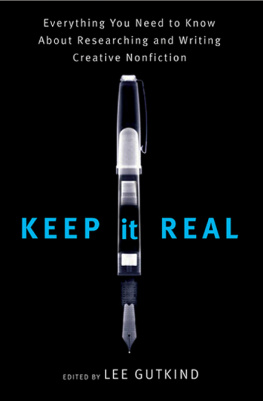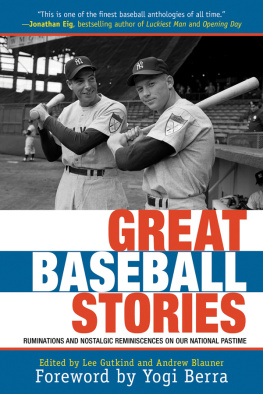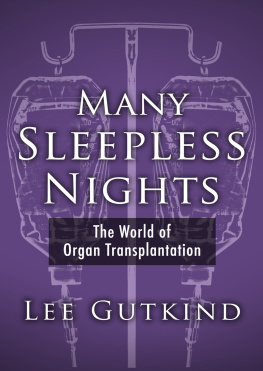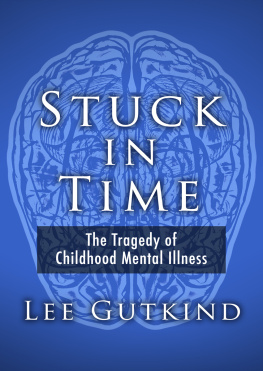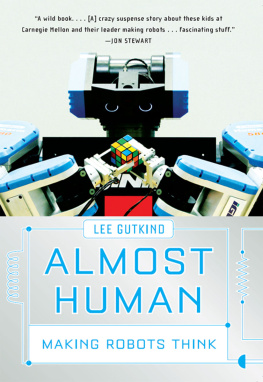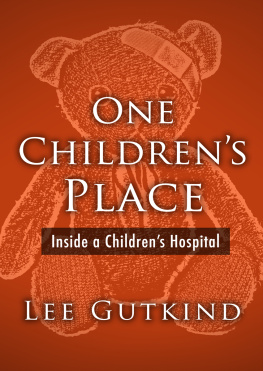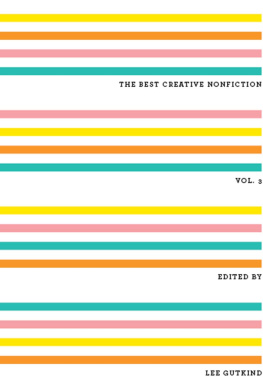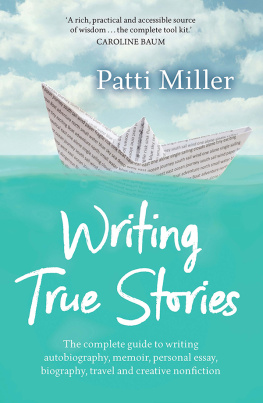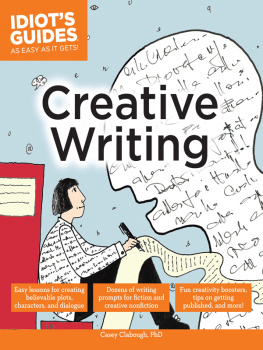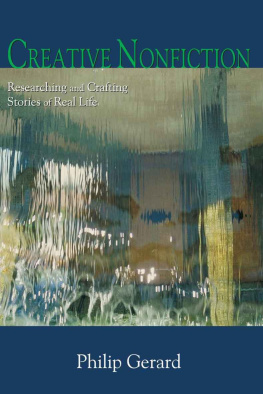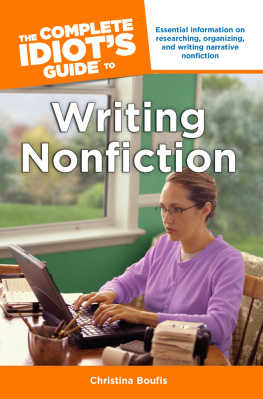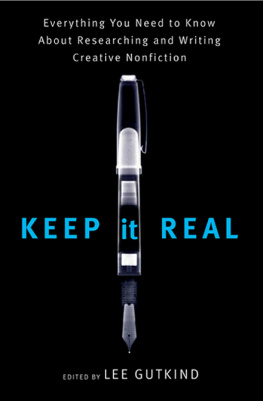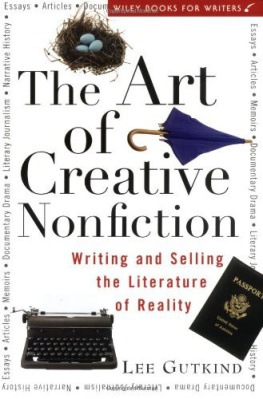
KEEP IT REAL
Everything
You Need to Know
About Researching
and Writing
Creative Nonfiction
Edited by Lee Gutkind
and Hattie Fletcher

W. W. Norton & Company
New York London
Contents
The ABCs of Creative Nonfiction was a group effort, and much of the writing in it evolved significantly over the course of compiling Keep It Real. Some of the entries include the work of more than one writer; most of the entries have been reworked by the editors to maintain a consistent tone and eliminate repetitions. For this reason, individual pieces are not credited to specific writers. The writers who contributed work are:
Robert S. Boynton | Brenda Miller |
Kristen Cosby | Dinty W. Moore |
Taha Ebrahimi | Paul Morris |
Hattie Fletcher | Dennis Palumbo |
Lee Gutkind | Lori Pfeiffer |
Meredith Hall | Mimi Schwartz |
Donna Hogarty | Bryant Simon |
Kristen Iversen | Bryant Simon |
Lori Jakiela | Sarah Z. Wexler |
Barbara Lounsberry | Susan Yohe |
Private and Public:
The Range and Scope
Lee Gutkind
This may come as a surprise, since I am often referred to as the godfather behind creative nonfiction (so anointed by Vanity Fair magazine), but I dont know who actually coined the term creative nonfiction. As far as I know, nobody knows exactly. I have been using it since the 1970s, although if we were to pinpoint a time when the term became official, it would be 1983, at a meeting convened by the National Endowment for the Arts to deal with the question of what to call the genre as a category for the NEAs creative writing fellowships. Initially the fellowships bestowed grant money (seventy-five hundred dollars at the time; twenty thousand dollars today) only to poets and fiction writers, although the NEA had long recognized the art of nonfiction and been trying to find a way to describe the category so writers would understand what kind of work to submit for consideration.
Essay is the term used to describe this artful nonfiction, but it didnt really capture the essence of the genre for the NEA or lots of other folks experimenting in the field. Technically, scholars, critics, and academics of all sorts, as well as newspaper op-ed reporters, were writing essays, although that was not the kind of work the NEA had in mind. Journalism didnt fit the category either, although the anchoring element of the best creative nonfiction requires an aspect of reportage. For a while the NEA experimented with belles-lettres, a misunderstood term that favors style over substance and did not capture the personal essence and foundation of the literature it was seeking. Eventually one of the NEA members in the meeting that day pointed out that a rebel in his English department was campaigning for the term creative nonfiction. I was that rebel.
Although it sounds a bit affected and presumptuous, creative nonfiction precisely describes what the form is all about. The word creative refers simply to the use of literary craft in presenting nonfictionthat is, factually accurate prose about real people and eventsin a compelling, vivid manner. To put it another way, creative nonfiction writers do not make things up; they make ideas and information that already exist more interesting and often more accessible.
This general meaning of the term is basically acknowledged and accepted in the literary world; poets, fiction writers, and the creative writing community in general understand and accept the elements of creative nonfiction, although their individual interpretation of the genres boundaries may differ. The essential point to acknowledge here is that there are lines, real demarcation points among fiction, which is or can be mostly imagination; traditional nonfiction (journalism and scholarship), which is mostly information; and creative nonfiction, which presents or treats information using the tools of the fiction writer while maintaining allegiance to fact.
There is, it is true, controversy over the legitimacy of creative nonfiction, both as a term and as a genre; it flares up regularly, perhaps even annually, every time a book like James Freys A Million Little Pieces, which purported to be a memoir but contains fictionalized events, is unmasked. Such scandals seem to inspire frenzies among literary and cultural critics, an excuse for predictable (but nevertheless often satisfying) expressions of schadenfreude and sanctimonious pronouncements about Truth in Art.
Ultimately, this controversy over the form or the word is not only rather silly but moot; the genre itself, the practice of writing nonfiction in a dramatic and imaginative way, has been an anchoring element of the literary world for many years. George Orwells Down and Out in Paris and London, James Baldwins Notes of a Native Son, Ernest Hemingways Death in the Afternoon, and Tom Wolfes The Right Stuff are classic creative nonfiction efforts, books that communicate information (reportage) in a scenic, dramatic fashion.
These four books represent the full spectrum of creative nonfiction: Baldwins work is memoir and therefore more personal or inward, dealing with the dynamics of his relationship with his father and the burden of race in America; Wolfes work is more journalistic or outward, capturing the lives of the early astronauts. Death in the Afternoon and Down and Out in Paris and London fall somewhere in betweenpersonal, like memoir, but filled with information about bullfighting and poverty respectively. I often refer to this combination as the parallel narratives of creative nonfiction; there is almost always a public and a private story.
At one point in history this kind of writing gained popularity as the New Journalism, in large part because of Wolfe, who published a book of that title in 1973. In it, he declared that the New Journalism would wipe out the novel as literatures main event. Gay Talese, in the introduction to Fame and Obscurity, his landmark collection of profiles of public figures including Frank Sinatra, Joe DiMaggio, and Peter OToole, describes the New Journalism thus: Though often reading like fiction, [it] is not fiction. It is, or should be, as reliable as the most reliable reportage, although it seeks a larger truth than is possible through the mere compilation of verifiable facts, the use of direct quotations, and adherence to the rigid organizational style of the older form.
This is perhaps creative nonfictions greatest asset: It offers flexibility and freedom while adhering to the basic tenets of reportage. In creative nonfiction, writers can be poetic and journalistic simultaneously. Creative nonfiction writers are encouraged to utilize literary and even cinematic techniques, from scene to dialogue to description to point of view, to write about themselves and others, capturing real people and real life in ways that can and have changed the world. What is most important and enjoyable about creative nonfiction is that it not only allows but also encourages the writer to become a part of the story or essay being written. The personal involvement creates a special magic that alleviates the suffering and anxiety of the writing experience; it provides many outlets for satisfaction and self-discovery, flexibility and freedom.
Next page
